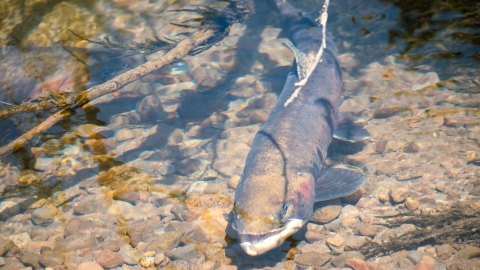On the screen appears a map of Northern Nevada with a slice of Eastern California. Colorful, diamond shaped markers are peppered across the map signifying recovery projects for Lahontan cutthroat trout. Faith Machuca, a Lahontan cutthroat trout recovery ecologist for the U.S. Fish and Wildlife Service in Reno, Nevada, walks me through the recently released database. “So, you can change the occupied transparency and...” bright green lines appear on the map. The lines highlight streams occupied by the threatened fish, stretching from Lake Tahoe to the edge of western Utah. What Machuca is showing me is called the Conservation Efforts Database, or CED for short. The CED is a web-tool that land and species managers can use to collectively archive and display conservation actions on an interactive map. Data for population demographics, habitat, genetics, and project information are stored in the database.
The CED will benefit stakeholders by breaking down information silos and providing access to all available data in real time, painting a picture of recovery efforts and their effectiveness. This makes recovery planning faster, more collaborative, and more efficient. According to Sean Vogt, the Service’s Lahontan cutthroat trout recovery coordinator, nothing like the CED has been tried before when it comes to Lahontan cutthroat trout recovery.
Before the CED was developed for Lahontan cutthroat trout, it was initially developed for greater sage-grouse, a large bird that calls the sagebrush biome home. It was unclear at the start what kind of effect this tool would have on recovery. But now, the CED has been in use for nearly a decade, and the data is helping to inform sagebrush ecosystem conservation at a broader scale. “Now that we've collected enough years of information, we’re starting to see its impact. The CED is now being used to evaluate restoration outcomes by looking at changes in vegetation at both local and biome-wide scales,” said Lief Wiechman, a scientist for the U.S. Geological Survey. With successful returns on investment being realized for sage-grouse and the sagebrush ecosystem as a whole, excitement is brewing for its use with Nevada’s state fish. The work carried out to build and develop the CED now sets the stage for its use in Lahontan cutthroat trout recovery.
The CED’s Lahontan cutthroat trout module has been in development for three years and was made possible through collaboration with the U.S. Geological Survey, Bureau of Land Management, U.S. Forest Service, National Resource Conservation Service, state wildlife agencies, Trout Unlimited, and the Service. Funding for the tool comes from several sources, including Trout Unlimited and the Service.
When asked how the CED will help conservation efforts between partners, Machuca replied, “One intent of the CED is more collaboration. If you see something going on at a watershed level, other agencies can get involved to pool funding, capacity, and resources. It has the potential to change how we implement recovery for the species.”
To fully realize the potential for collaboration, a team of USGS and Service scientists and other partners built the tool to act as a centralized database to review, track, and monitor recovery efforts across agencies and partnerships. They made the tool so that land and species managers could upload data built upon four pillars. The four pillars of data in mind are as follows: demographics, habitat condition, genetics, and conservation efforts/projects.
One reason that this information becomes so important is due to the large range of the species, which spans from the Eastern Sierra across northern Nevada and into a small part of southern Oregon. The scale of the potential range for Lahontan cutthroat trout means that biologists have a massive area to cover when it comes to strategizing, planning, and implementing recovery actions. “From my conversations, other Service members and partners agree, this is going to be essential in recovering the species. You need to have a centralized location to store and view your data in order to coordinate from a range wide perspective,” says Machuca.
By introducing the CED to recovery planning, there is opportunity for land managers to better see new and collaborative opportunities for Lahontan cutthroat trout restoration. “The CED helps to tell the story of conservation practitioners and helps gather information to evaluate effectiveness so limited resources can be put to use in areas with a higher return on investment.”said Wiechman. With the right database and visualization capability, biologists will have a key tool to help explore the vast world of Lahontan cutthroat trout data. Machuca, the CED Team, and the entire Lahontan cutthroat trout recovery team, approach this exploration with passion and excitement. They see a story unfolding in the data that can transform recovery efforts across the landscape.
“The ultimate goal is delisting,” Machuca states.“Being able to coordinate on a range-wide scale is going to be important for doing that. It's going to make [our work] a lot more efficient and effective.”









